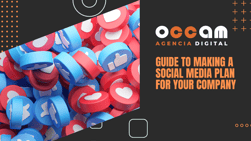Index Content
There are many people who believe that social media and social networks are synonymous words that mean the same thing. Are you one of them? If so, in this post we want to give you all the information you need to find out for sure and discover that this concept... goes much further!
Social media is the set of resources, platforms, applications and media through which brands will be able to build their Inbound Marketing plan, exchange information, generate conversation and establish contacts with all potential users interested in interacting with the brand.
However, although the name may give rise to confusion, social media is not only social networks, but also includes websites, forums, blogs, etc. Despite this, it is the social networks that play the most important role when it comes to establishing our inbound marketing strategy. But why?
Social media helps to create and especially to strengthen the link between the public and the brand. Nowadays, for many people, social networks are the place where they spend most of their time on the internet. Being present and active on the same sites as the users in turn promotes closeness and can help us to eliminate the barriers between the public and the brand. And this is one of the main objectives of our inbound marketing strategy.
how to use social media to accompany my Inbound strategy?
It is also important to understand, at this point, how the concept of marketing is applied and related to social media. This part of the strategy includes the part of marketing that every brand carries out on social networks through actions that make its products or services known to users. This will help to capture the target audience and be in constant contact with them, even getting feedback from them in real time.
This is why focusing part of our Inbound Marketing strategy on social media and, more specifically, on social networks, will help us to generate a good relationship with our audience. What this tool allows is to create an immediate contact, dialogue in real time with the brand and help users to make a decision more quickly since, in the times we live in, we have become accustomed to wanting an immediate response when we search for something on the internet. It is therefore important to know that these answers will be provided by the social networks themselves, blogs, or even the brand's own website that has a direct chat.
As forsocial networks, it is important to know in which of them we have to position ourselves more strongly than in others, depending on the target audience we want to reach. It is not necessary that our brand is in each and every one of the social networks that exist in the world, but in those that will make us win over users.
For example, if we want to attract a younger audience, it would be a good idea to develop a large part of our strategy on Instagram or YouTube, which are the platforms that are most popular with this type of user. On the other hand, if we want to target a more adult audience, it would be a good idea to develop a large part of our social media plan on Facebook.
Therefore, we will have to assess which networks can be most useful for our Inbound Marketing strategy and know in which of them to develop our social media plan that will make us achieve the objectives that we have been naming throughout the post.
social networks , as we have already mentioned, will be the main engine of our inbound marketing strategy, but they will not constitute the whole plan as other tools that are part of social media can be very useful when it comes to promoting our brand on the Internet with the Inbound Marketing technique we have chosen. We will now go into detail of other tools that can be useful to accompany the actions in social networks that we have seen above.
Firstly, the website of our brand will be one of the tools that will also be very useful for our social media strategy. As we mentioned earlier, the networks will generate traffic to our website and, therefore, to our products or services. Therefore, our web platform should be clear and concise, showing the features of our products or services, visually attractive to the user and have a customer service where we can resolve any questions that may arise.
Another option that we can also consider would be the creation of a blog, which can be accessed through our website. This can include posts accompanied by videos or images that explain the purpose of our brand, who we are or how our products or services work. This will help users to decide for our brand, as finding a place where it is explained in detail and has visual support (videos or images) will be a very valuable factor for our target audience.
Benefits of having a social media strategy in our Inbound plan
In summary, we can say that social media is a fundamental part of the Inbound Marketing strategy that our brand is carrying out, as, in addition to having the most immediate news, it will have other very important benefits such as:
- Dissemination: they are a very valuable channel to make ourselves known among our target audience, which will help us to increase the number of visits to our website, and therefore, to the knowledge of our services.
- Promotions and offers: we can attract users to become our customers by launching promotions and offers on our social networks. We can also take advantage here of the viral effect that we mentioned earlier to give greater diffusion to our brand.
- Brand awareness: through social networks we can provide users with information so that they can get to know our brand through the platforms that they themselves use on a daily basis.
In addition, it is also important to take into account the benefits that social networks will offer us when developing part of our strategy on them, among which we can highlight:- Helping to create a community among users both in the short and long term.
- Be aware of the main trends and be able to anticipate the launches of other brands.
- Generate quality traffic through social networks to our website, which we can then capture to convert them into leads.
- Social networks allow virality in a very simple way, as users can share content with others immediately and will make our products or services reach further thanks to recommendations.
With all this we can conclude that, both social networks and our website, our blog or any other resource that allows us to communicate with the user and help them become customers are part of the social media that will help us to boost our brand through the Inbound Marketing strategy.




